Expert Q&A: Elizabeth Allen, Ph.D.
By Amy Nelson
What prompted you to start a graduate program in Ecology, Spirituality, and Religion at the California Institute of Integral Studies (CIIS)?
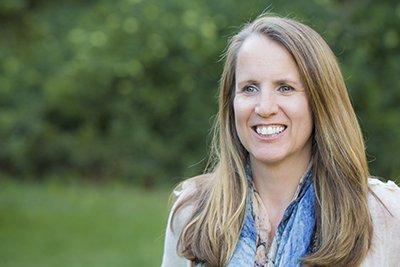
The short answer is that I wanted to start the graduate program I was looking for but couldn’t find when I was a student. I had been interested in how religious and spiritual perceptions influence how people think and act with regard to the environment. In the 80s and 90s, you could find some intimations of that in nature writing, but there wasn’t really much scholarly discussion.
As a graduate student at Yale, I did a master’s in environmental management and a simultaneous master’s in religion so I could look at how those two areas of inquiry mutually influence each other, but there wasn’t a structured joint degree program as there is now at Yale. In my doctoral studies at Berkeley, I continued in the same vein.
In the late 1990s and early 2000s, the academic field of religion and ecology started to take off. As we started to learn so much more about climate change and biodiversity loss, policymakers, scholars, and scientists began to realize that technocratic policies did not always resonate with different groups of people, and they wondered if there were other ways to engage people in caring for the natural world that extended beyond the usual tools of policy, economics, and science. At the same time, scholars of religions were retrieving and re-constructing ecological dimensions within the world’s religions, and calling on the religion to become more engaged with environmental issues. The world’s religions provide moral authority for millions of people. Religious practitioners are already organized and hold a shared system of beliefs. So scientists, scholars, and policymakers began to try to reach out to religions and invite them into a dialogue about the state of the environment, and the religious response to environmental degradation.
By 2009, I had joined the faculty at CIIS and started teaching a program within the department of Philosophy and Religion. Two of the founders of the academic field of religion and ecology, Mary Evelyn Tucker and John Grim, who direct the Forum on Religion and Ecology at Yale,, approached CIIS and encouraged us to launch a graduate program in religion and ecology. So we spent a few years consulting colleagues all over the country to assess needs and interests, and the graduate program launched in 2013.
Are there others like it in the US? The world?
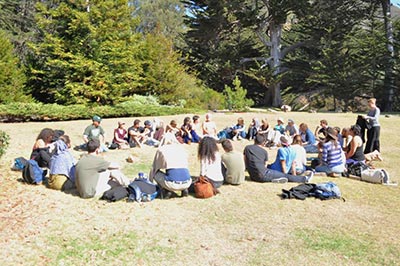
There is no program exactly like ours in the world, but there are some that are similar. Drew Theological Seminary was one of the very first programs to offer a doctorate in religion which emphasized religion and environmental studies. In 2002, the University of Florida established a PhD in Religion and Nature within their department of religion. In 2006, Yale established a joint Masters in Religion and Ecology, directed by Mary Evelyn Tucker and John Grim, between the School of Forestry and Environmental Studies and the Divinity School.
In your paper “Waste and Worldviews: Garbage and Pollution Challenges in Bhutan,” you looked at how religion factors into waste management in one of the world’s least developed, yet most rapidly developing nations. What did you learn about the relationship between waste and religion, and how can that knowledge be applied more broadly?
I learned that there were two different definitions of “pollution.” There was the material view of pollution held by elite policymakers in the capital, but there was also a spiritual understanding of pollution held by rural villagers. Rural villagers are much more concerned with the spiritual pollution that arises from behavior that is considered inappropriate, such as fighting, shouting, eating strong foods, or eating in the wrong place. These activities anger the gods and create spiritual pollution, which they believe can then cause illness, or affect crops.
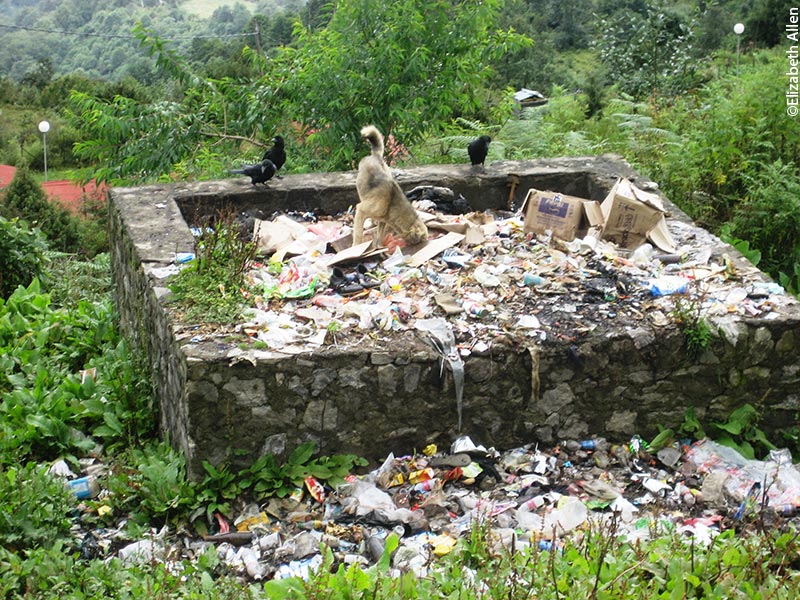
The Bhutanese government [which had initiated new waste management initiatives in 2007] was telling people to “clean up pollution,” and by that they meant litter. But that mission didn’t resonate with rural people because they didn’t see litter as having any polluting ability. The point is that there were two definitions in conflict with each other and the government didn’t seem to be thinking about the spiritual definition, so their policies were not gaining traction with rural people.
That’s one of the biggest lessons from this research: understand cultural values. The Western, rationalist values that we learn at university in the U.S. are not the only values in the world. If we are engaged in conservation, we must be aware of the values people hold that may influence how they accept our projects.
You have written about high mountain communities where the impacts of climate change are visible in the form of melting glaciers, and where cultures are strongly influenced by religions with an animistic perspective of the landscape. In earlier issues of Leaf Litter, we have touched on the economic and psychological impacts of climate change on immediately vulnerable communities, but not the spiritual. What did you learn about the spiritual impact of climate change on these communities? Does this additional layer of loss to these communities become an issue of environmental justice?
It is absolutely an issue of environmental justice. The social losses are what ethnobotanist Nancy J. Turner and her colleagues call “invisible losses.” If someone experiences damage from an environmental harm, we often think of loss of property or growing capacity. But if a community is not able to practice their rituals in the way that they have for hundreds of years, that represents a profound shift.
Melting glaciers are changing the relationships between people [in sacred mountain landscapes in the Peruvian Andes, Nepalese Himalaya, and Meili Snow Mountains of Yunnan, China] and their local gods. The local people assume that their gods are angry and that they’ve done something wrong. That’s a big psychological burden to take on. In my paper “The spiritual significance of glaciers in an age of climate change,” I point out that for these communities, this [burden] is caused by carbon emissions that come from thousands of miles away. These mountain people contribute very little to the global carbon budget, yet they are directly and daily experiencing consequences of climate change. That can upset social hierarchies, customs, and traditions. If we look at Native Americans in the U.S., we know that when you rip the fabric of custom, tradition, and spirituality, it has very devastating effects on culture and community, and those effects ripple for generations. In my paper, I was calling for greater awareness of those effects and for more research on the emotional, spiritual, and subjective consequences of climate change.
You state that “additional social scientific research on how religious communities perceive and respond to climate change is needed.” What specific research effort would you like to see undertaken?
I’d like to see more qualitative social research, where we find out what people are experiencing and how they relate it to their culture, local values and priorities, and spiritual perceptions. I’d want it to be very participatory, where researchers ask the communities, “What are YOUR priorities? What do you want to know about how these melting glaciers affect your community?” They might want to know how it affects water for irrigation, or where they can graze their livestock, or other pragmatic issues.
Are there lessons about the ways high mountain cultures have adapted to climate change that can and should be shared with the rest of the world?
There is a mountain village in Zanskar, India called Kumik. This village is in the rainshadow of the Himalayas, and very dry, so the villagers depend on water from the glaciers to irrigate their crops. As the glaciers have receded, the water wasn’t reaching the village. Eventually, the village had a community process where they decided to shift to a location that had a much larger, regularly flowing river. [Three American researchers assisted the community with this process.] So that’s an example of community process and resilience in the face of climate change. But…they’re losing their history, and their long-term, ancestral connection to a particular area of land that they have known very deeply. There is, again, an “invisible loss” of culture and community.
In “Religion Inscribed in the Landscape: Sacred Sites, Local Deities, and Natural Resource Use in the Himalayas” a chapter you contributed to the book The Changing World Religion Map, you discuss communities whose concepts of nature and life are largely shaped be the religious significance of certain landscape features. Can you explain the term “environmental imaginaries” and share an example from one of the regions you studied?
The term “environmental imaginaries” is used by political ecologists Richard Peet and Michael Watts in their book Liberations Ecologies: Environment, Development, Social Movements to describe the mental constructs that people have about their environment—the mental pictures or understandings that guide the way people live, work, and play in their surroundings. I like this term because it’s a bit broader than a materialist understanding of the environment and it suggests a reciprocal relationship between the way people understand their environment and what they do in their environment. Peet and Watts say that environmental imaginaries are often carried in ritual, symbolic, or mythic portrayals.
Can you share an example of an environmental imaginary?
In eastern Bhutan, most people believe that the landscape is inhabited by deities that express demands about what people do. People are required to give propitiations to the deities, for example. Not serving the deities properly can result in sickness, crop failure, or injury.
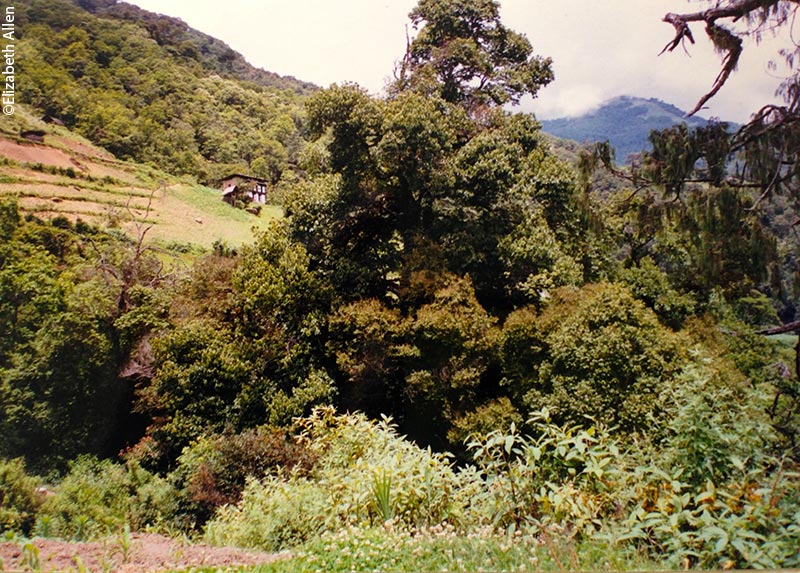
In the context of a Western, rationalistic, scientific point of view, that sounds ludicrous. But when we understand that environmental imaginaries are often conveyed in symbolic and mythic terms, we can say, “Okay, those rural, religious people understand that proper interactions with their surroundings are essential to maintaining their food supply and the fertility of the landscape.”
What are the influences—real and potential—that sacred sites of various religions can have on biodiversity conservation?
There has been quite a lot of study in India, Southeast Asia, and Africa, on the potential for sacred groves to support biodiversity conservation. Sacred groves are often more biodiverse than the surrounding landscape, and in many cases, they have relic species not widely found on the surrounding landscape. Some scientists have suggested that sacred groves are a kind of in situ biodiversity conservation area where plants can propagate, the seedbank is maintained, and seeds are dispersed from the area. These groves often serve as refugia for wildlife within a human modified matrix. [The idea of sacred groves as biodiversity conservation sites] has received quite a lot of interest from Western scientists because it seems to be a method of biodiversity conservation that doesn’t require additional buy-in. It’s already happening, local people are already managing it, and it is in concert with their beliefs and practices. Clearly sacred groves can’t substitute for large, protected tracts of land, but in terms of working with local people and being harmonious with local values, they do offer that benefit. A great book on this topic is Sacred Groves and Local Gods: Religion and Environmentalism in South India by Eliza Kent.
You have written that “…moral and ethical norms have thus far been unable to gain purchase on climate change.” Do you think documents and statements such as Pope Francis’ recent environmental encyclical, the Islamic Declaration on Global Climate Change, the Buddhist Declaration on Climate Change and more recent Climate Change Statement to World Leaders “Rabbinic Letter on the Climate Crisis” are signs that this is changing?
Absolutely. This is a tremendous development. These statements are motivated by the upcoming Paris climate talks, and it is wonderful to see these religious communities taking a very strong stand on what needs to happen. I think this is also a culmination of several decades of work by people in the religious and scientific communities calling on the religions to get involved and take a moral stance.
The Pope’s encyclical clarifying how “care for creation” as a moral obligation is tremendously powerful. Some people have said it is the most historic document we’ll see in our lifetime. It has been wonderful to hear that different church and community groups are reading and studying the encyclical and making those connections between their faith and larger obligations to the natural world.
What do you think we can expect to see from religious communities/leaders at the UN Climate Change Conference in Paris?
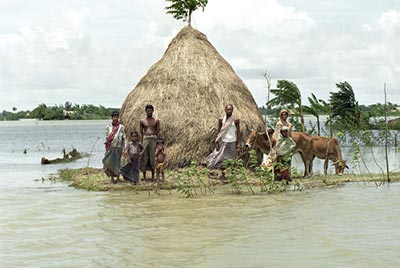
I hope we’ll see religious communities continuing to put pressure on their states and negotiators to implement stringent enough plans to have a reasonable chance to stay under the two degree threshold. I think we may also see greater emphasis on the current and potential suffering of the poor and marginalized people in less developed countries. All the data says that the worst effects of climate change are going to be experienced in the least developed countries. We may see an increasing moral argument to do something to reduce the suffering of those people. With the current refugee crisis in Europe, we may also see more attention to the climate refugees we can continue to expect. That may be another piece of the moral argument that religious groups put forward.
Generally speaking, do those religions that regard care for Earth as a moral obligation take that stance because: a) scripture/teachings dictates that they do, b) it is a form of honoring creation/deity, c) it is part of caring for the human community, or d) out of some other sense of duty/respect?
It’s tough to generalize, but many religious traditions have some notion of caring for or praising creation or the Creator. This necessity of taking on concern for the earth is very modern. When there were a lot fewer people on the planet, this wasn’t essential because small groups of people could shift to different areas, or simply abandon cities and start somewhere else. Resources seemed abundant. Environmental degradation is a modernist dilemma. That’s where the Yale Forum on Religion and Ecology has been very helpful. The scholars associated with the Forum have engaged in the retrieval, re-evaluation, and reconstruction of ecological themes within religious texts, symbols, and rituals. Through critical re-engagement with religious text and practices, scholars have located passages or practices that are relevant to the current moment, in expressing concern and care, and valuing creation. This active engagement helps religious traditions remain current and relevant. These processes help [different religious communities] find the textual authority for engaging in creation care.
What are you working on now?
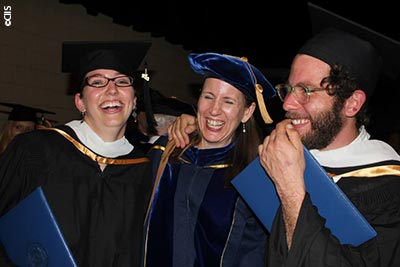 Two weeks from now, I’m meeting with a group of environmental conservationists and religious leaders in London at the Faith in Conservation meeting, which was called for by the Alliance of Religions and Conservation and The Nature Conservancy. We are going to look at how religions and people in conservation can better work together, support each other, and improve conservation outcomes. That is tremendously exciting. The meeting will be opened by HRH Prince Phillip, who , as International President of WWF, called together a group of environmental organizations and religious leaders in Assisi in 1986 and asked, “How can religions support environmental conservation?” Out of that grew the Alliance of Religions and Conservation. ARC has been a leader in helping faith communities throughout the world to enact their values through environmental conservation.
Two weeks from now, I’m meeting with a group of environmental conservationists and religious leaders in London at the Faith in Conservation meeting, which was called for by the Alliance of Religions and Conservation and The Nature Conservancy. We are going to look at how religions and people in conservation can better work together, support each other, and improve conservation outcomes. That is tremendously exciting. The meeting will be opened by HRH Prince Phillip, who , as International President of WWF, called together a group of environmental organizations and religious leaders in Assisi in 1986 and asked, “How can religions support environmental conservation?” Out of that grew the Alliance of Religions and Conservation. ARC has been a leader in helping faith communities throughout the world to enact their values through environmental conservation.
I am also excited about a Bay Area religion and ecology summit we are hosting at CIIS this spring on March 11. We will bring together religious leaders, environmental scientists, land managers, environmental justice leaders, and others involved in conservation to discuss how we can be more effective and work together. We intend to build a network of people interested in religion and ecology here in the San Francisco Bay Area.
Many of our readers are planners, designers, biologists, and engineers but very few are likely working in places like the Himalayas. Can you offer advice on how to better engage religious communities in the places they work in ways that meet those communities’ needs and harness their power to affect change?
First of all, be aware of religious groups. So many of us who are trained as scientists or planners [are accustomed to] a very rationalistic approach to understanding the world. Recognize that religion is very important to many people, and it provides set of powerful values that guide people’s lives in certain ways. [Bring to your work] a curiosity about what those values are, and in what ways they may overlap or intersect with secular values that might be guiding environmental restoration or conservation.
I am also interested in values that guide environmentalists. Many people who do environmental work have some deep connection to a place or an organism that is very meaningful to them and gives them inspiration. I would call those spiritual values. So I would advise your readers to let those values come out in their work and in the environmental movement. Recognize and own your own spiritual values. They may be secular, but they are part of this connection we have with the natural world that is very motivating. Sometimes in the process of developing plans, policies, and economic analyses, we can lose touch with what really inspires us.
